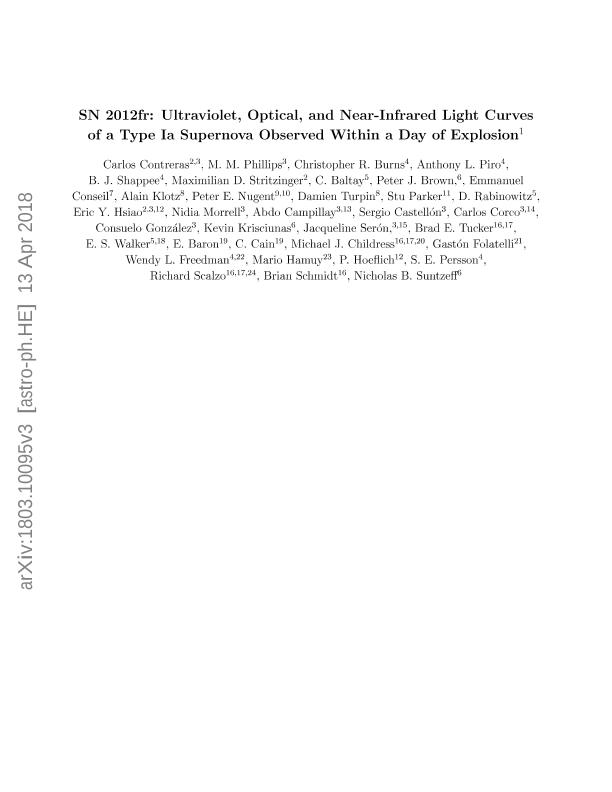Artículo
SN 2012fr: Ultraviolet, Optical, and Near-infrared Light Curves of a Type Ia Supernova Observed within a Day of Explosion
Contreras, Carlos; Phillips, M. M.; Burns, Christopher R.; Piro, Anthony L.; Shappee, B. J.; Stritzinger, Maximilian D.; Baltay, C.; Brown, Peter J.; Conseil, Emmanuel; Klotz, Alain; Nugent, Peter E.; Turpin, Damien; Parker, Stu; Rabinowitz, D.; Hsiao, Eric Y.; Morrell, Nidia Irene ; Campillay, Abdo; Castellón, Sergio; Corco, Carlos; González, Consuelo; Krisciunas, Kevin; Serón, Jacqueline; Tucker, Brad E.; Walker, E.S.; Baron, E.; Cain, C.; Childress, Michael J.; Folatelli, Gaston
; Campillay, Abdo; Castellón, Sergio; Corco, Carlos; González, Consuelo; Krisciunas, Kevin; Serón, Jacqueline; Tucker, Brad E.; Walker, E.S.; Baron, E.; Cain, C.; Childress, Michael J.; Folatelli, Gaston ; Freedman, Wendy L.; Hamuy, Mario; Hoeflich, P.; Persson, S. E.; Scalzo, Richard; Schmidt, Brian; Suntzeff, Nicholas B.
; Freedman, Wendy L.; Hamuy, Mario; Hoeflich, P.; Persson, S. E.; Scalzo, Richard; Schmidt, Brian; Suntzeff, Nicholas B.
 ; Campillay, Abdo; Castellón, Sergio; Corco, Carlos; González, Consuelo; Krisciunas, Kevin; Serón, Jacqueline; Tucker, Brad E.; Walker, E.S.; Baron, E.; Cain, C.; Childress, Michael J.; Folatelli, Gaston
; Campillay, Abdo; Castellón, Sergio; Corco, Carlos; González, Consuelo; Krisciunas, Kevin; Serón, Jacqueline; Tucker, Brad E.; Walker, E.S.; Baron, E.; Cain, C.; Childress, Michael J.; Folatelli, Gaston ; Freedman, Wendy L.; Hamuy, Mario; Hoeflich, P.; Persson, S. E.; Scalzo, Richard; Schmidt, Brian; Suntzeff, Nicholas B.
; Freedman, Wendy L.; Hamuy, Mario; Hoeflich, P.; Persson, S. E.; Scalzo, Richard; Schmidt, Brian; Suntzeff, Nicholas B.
Fecha de publicación:
05/2018
Editorial:
IOP Publishing
Revista:
Astrophysical Journal
ISSN:
0004-637X
Idioma:
Inglés
Tipo de recurso:
Artículo publicado
Clasificación temática:
Resumen
We present detailed ultraviolet, optical, and near-infrared light curves of the Type Ia supernova (SN) 2012fr, which exploded in the Fornax cluster member NGC 1365. These precise high-cadence light curves provide a dense coverage of the flux evolution from -12 to +140 days with respect to the epoch of B-band maximum (). Supplementary imaging at the earliest epochs reveals an initial slow and nearly linear rise in luminosity with a duration of ∼2.5 days, followed by a faster rising phase that is well reproduced by an explosion model with a moderate amount of 56Ni mixing in the ejecta. From our analysis of the light curves, we conclude that: (i) the explosion occurred <22 hr before the first detection of the supernova, (ii) the rise time to peak bolometric (λ > 1800) luminosity was 16.5 ±0.6 days, (iii) the supernova suffered little or no host-galaxy dust reddening, (iv) the peak luminosity in both the optical and near-infrared was consistent with the bright end of normal Type Ia diversity, and (v) 0.60 ±0.15 M o of 56Ni was synthesized in the explosion. Despite its normal luminosity, SN 2012fr displayed unusually prevalent high-velocity Ca ii and Si ii absorption features, and a nearly constant photospheric velocity of the Si ii λ6355 line at ∼12,000 that began ∼5 days before . We also highlight some of the other peculiarities in the early phase photometry and the spectral evolution. SN 2012fr also adds to a growing number of Type Ia supernovae that are hosted by galaxies with direct Cepheid distance measurements.
Palabras clave:
Supernovae: General
,
Supernovae: Individual (Sn 2012fr)
Archivos asociados
Licencia
Identificadores
Colecciones
Articulos(IALP)
Articulos de INST.DE ASTROFISICA LA PLATA
Articulos de INST.DE ASTROFISICA LA PLATA
Citación
Contreras, Carlos; Phillips, M. M.; Burns, Christopher R.; Piro, Anthony L.; Shappee, B. J.; et al.; SN 2012fr: Ultraviolet, Optical, and Near-infrared Light Curves of a Type Ia Supernova Observed within a Day of Explosion; IOP Publishing; Astrophysical Journal; 859; 1; 5-2018
Compartir
Altmétricas



